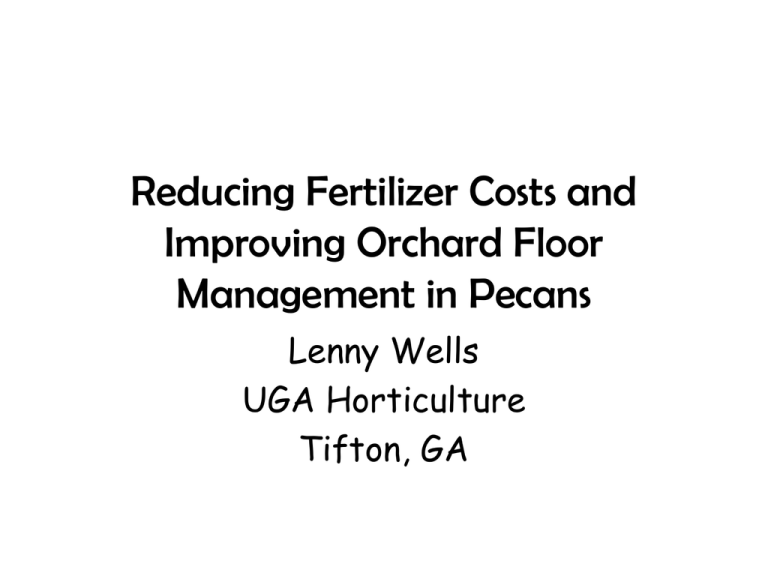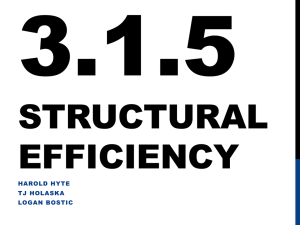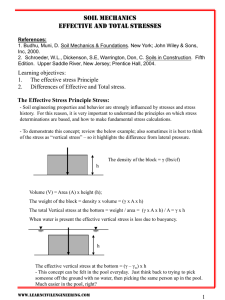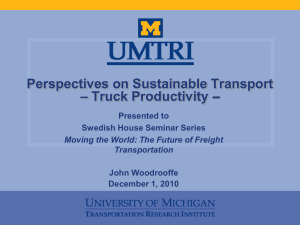Reducing Fertilizer Costs and Improving Orchard Floor Management
advertisement

Reducing Fertilizer Costs and Improving Orchard Floor Management in Pecans Lenny Wells UGA Horticulture Tifton, GA Unit Lime Fertilizer, Chemical, and Irrigation Costs Per Acre: Full Production, 2002 /2006 /2008 Quant. 1 ton/A Price/Unit $22/$28/30 Total/A $22/28/30 N 150 lbs $0.30/.70/1.00 $45/105/150 P 40 lbs $0.25/0.32/0.73 $10/12.80/29.20 K 60 lbs $0.14/0.24/0.83 $9.80/16.80/49.98 Zn Sulfate 50 lbs $0.30/0.35/0.8 $15/17.50/40 Fungicides 8/8 Appl.* $9.89 $79.12 Herbicides 3 Appl $5.50/$29.25 $16.50/87.75 Insecticides 10 $10/14.41 $100/144.16 Fuel Gal 33 Gal $.95/$2.25/4.75 $31/$74.25/156.75 Irrigation $46.84/48/50 Total Variable Pecan Production Costs 2002-2008 1200 1000 800 Cost per Acre ($) 2002 2006 2008 600 400 200 0 Year Pecan Fertilizer Trends 2002-2008 160 Cost Per Acre ($) 140 120 Lime N P K Zn 100 80 60 40 20 0 2002 2006 2008 Pecan Returns 2002 2006 2008 Production 1000 1000 1000 Price 1.00 1.58 1.30* Variable Costs 567.36 692.09 1191.17 Can We Reduce This Number? Return 432.64 887.91 108.83 Are we using too much N? • Yield and leaf N of Mature ‘Stuart’ trees in good condition did not respond to N at rates of 0-120 lbs/A until 6 years later (Worley 1974). • Pecan Orchards cycle nutrients Why do you have a herbicide strip? Band Applications • Apply fertilizer over the herbicide strip/drip emitter line • More efficient/reduced fertilizer cost • Determine area of application! •40 X 40 •12 foot wide herbicide strip: •12/40 = 30% •Can reduce area that you apply fertilizer to by 70% with band application At a rate of 75 lbs per acre: 100 acres X 75 = 7500 lbs N 7500 X .30 = 2250 lbs N •At $1/lb = a savings of $52.50 per acre with band application Broadcast Band Application Liquid 28-0-0-5 applied over herbicide strip Effect of N Application Method on ‘Stuart’ Pecan Treatment Leaf N Crop Load Injection 2.98a 60.6a Broadcast Band Broadcast 2.89ab 50.2b 2.85b 51.2ab Liquid N Herbicide Sprayer 2.80b 54ab Poultry Litter • Have sample analyzed • Typically: N 60 lbs/A P 60 lbs/A K 40 lbs/A Ca 30 lbs/A Zn 0.6 lbs/A Cu 0.6 lbs/A Nutrients are organically bound • 60% (36 lbs N/ton) is available for crop uptake during the season. • Do not apply after first week of June • Use BROILER litter and NOT LAYER litter • Ca/Mg Poultry Litter Costs • Total Synthetic Cost N,P,K,Zn = 162.66/A • 1 ton litter = $35-$50/A – 1 appl.: $50/Acre for 39 lbs N, 48 lbs P, +K, +Zn – 2 appl.: $100/Acre for 78 lbs N, 96 lbs P, +K, +Zn • Not much difference if N is only benefit (@ $50/ton) N Credit for Legumes • General N Recommendation for Pecans – 10 Lbs N/ 100 lbs expected crop • Crimson Clover – Year 1 = Replaces 30 lbs N/Acre • On Year = 150 lbs N-30 lbs N = 120 lbs N/Acre • Off YEAR= 75 lbs – 30 lbs = 45 lbs N/Acre – After 3 Years = Replaces 75-150 lbs N/Acre • On Year = 150 lbs N – 100 lbs N = 50 lbs N/Acre • Off Year = No additional N required Effect of Clover on Organic Matter and N Sample Site Soil Nitrate-N Soil Organic Matter 4” Sod 3.78 1.34 8” Sod 4.18 1.66 4” Sod+Clover 8” Sod + Clover 13.95 2.32 10.75 2.90 Orangeburg Loamy Sand Why is Organic Matter Important? • Higher inputs required with lower organic matter • Increased Water-Holding Capacity • Nitrate provided to plants via mineralization as soil organisms decompose organic matter • Neg. charged humus holds K, Ca, Mg, preventing loss • Provides natural chelates that keep Zn and Cu in forms plants can use • Reduced compaction, better water-holding capacity, reduced erosion • Slows down (Buffers) changes in pH • For every 1% increase in organic matter , 10 lbs N released • Crop yield increased 12% for every 1% increase in organic matter Growing Clover and Pecans • • • • • • • Allow clover to re-seed Adequate soil K and P levels Keep pH between 6-7 Good seed-soil contact. Plant as soon as possible after harvest Control competing grasses and weeds. Allow clover to re-seed before mowing Durana White Clover • Perennial, low growing, hardy, spreads by stolons, drought tolerant, persistent. • Developed by Dr. Joe Bouton, forage breeder at Tifton, from hardy native strains of white clover in Georgia. Bill Goff Crimson Clover • Cool-season annual, but reseeds well in the south • Seeds out in late May/June • May require re-seeding every 3-5 years depending on soil type Planting Clover DURANA • Plant 3-4 lbs. seed, preinoculated, in late September-November. • Seed costs $6.50 per lb., • $19.50 to $26 per planted acre. CRIMSON • Plant 15-18 lbs/A drilled; Increase seeding rate by 25% where broadcast • Inoculate seed • Seed cost: $1.50$2.00/lb • $22.50-$36 per planted acre • One advantage for a tough perennial clover is that, once established, it is difficult to kill with herbicide. • 1 pt of 2,4-D, in January, will kill small wild radish plants and is tolerated by established white clover. • 9 ounces of glyphosate, as a chem-mow, will not hurt clover much, and will suppress many weeds, reducing need for mowing. Bill Goff Bill Goff Bill Goff Treated with wiper, 5% glyphosate, 2% 2,4-d amine , 15 days earlier No wiper trt., mowed 15 days earlier Bill Goff Chem-Mowing vs Mechanical Mowing • Chem Mowing---Application of low herbicide (glyphosate) rates (6 oz/A) • Provides 45-90 Days Control • 2 Applications/Season • At least ½ the cost of mechanical mowing Chem Mowing Can Help Minimize Drought Stress • Mechanical mowing of weeds stimulates growth and increases uptake of soil water • Chem mowing does not lead to increased uptake of soil water, making more moisture available to trees • Fertility and orchard floor management programs should focus on reducing cost, increasing N use efficiency, and improving orchard soils.







